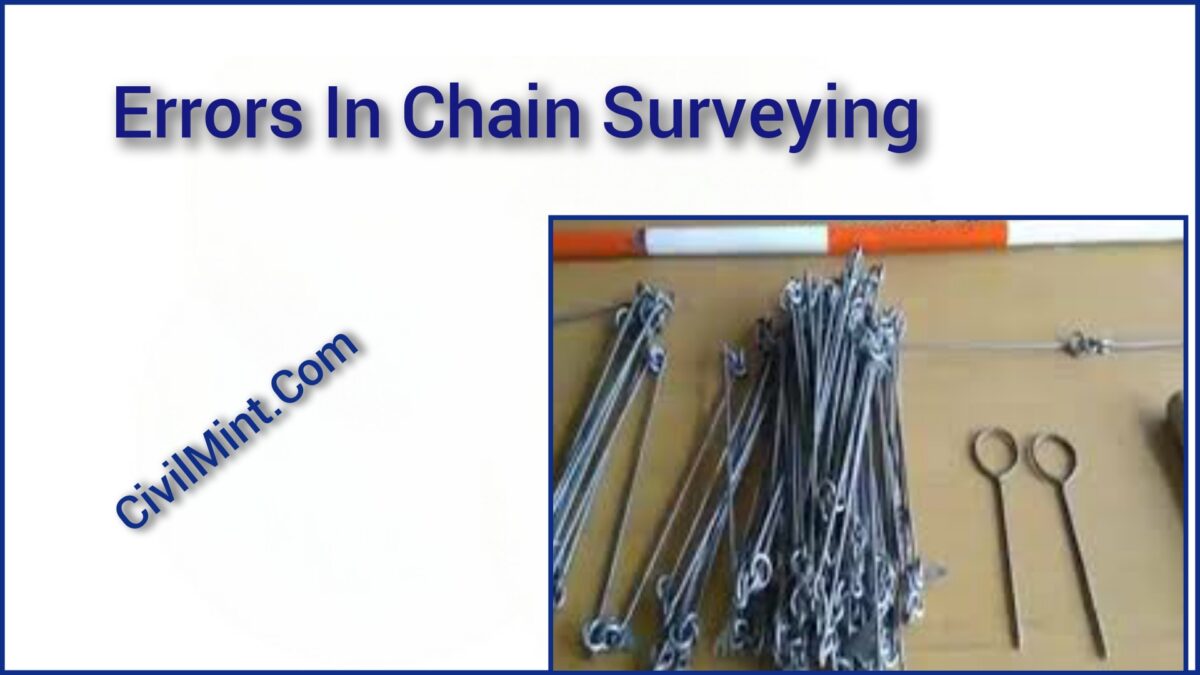There are three types of errors in chain surveying. These are personal errors, compensating errors and accumulating errors.

We will discuss these errors in chain surveying and how to minimize these errors.
Let us learn about these 3 types of errors in chain survey.
Table of Contents
1. Personal Errors In Chain Surveying
Personal errors are caused by the person performing the measurements. These errors may occur due to a lack of skill or experience, poor judgment, or even fatigue. Personal errors can be difficult to detect and correct because they are subjective and dependent on the person making the measurements.
Examples of personal errors in chain surveying include:
- Misalignment of the chain: This occurs when the person holding the chain is not in line with the other end, resulting in an incorrect measurement.
- Incorrect marking of chain lengths: If the person marking the chain lengths makes a mistake, the measurement will be incorrect.
- Incorrect sighting: This occurs when the person sighting the object being measured is not accurate, resulting in an incorrect measurement.
To minimize personal errors, it is essential to train and select personnel carefully, use proper techniques, and take steps to reduce fatigue.
2. Compensating Errors In Chain Surveying
Compensating errors are errors that occur in opposite directions and cancel each other out. These errors are caused by various factors that affect the length of the chain, such as temperature, tension, and sag. Because these factors can cause errors in either direction, they can cancel each other out, resulting in a net measurement that is closer to the true value.
Examples of compensating errors in chain surveying include:
- Temperature variations: As the temperature changes, the chain expands or contracts, resulting in a measurement that is either longer or shorter than the actual distance. However, if the temperature changes in the opposite direction during the return measurement, the error will be compensated for.
- Tension variations: If the tension in the chain is not consistent, the measured distance will vary. However, if the tension is higher in one measurement and lower in the other, the errors will be compensated for.
- Sag: If the chain sags, the measured distance will be longer than the actual distance. However, if the chain sags in the opposite direction during the return measurement, the error will be compensated for.
To minimize compensating errors, it is essential to use a standard tension for the chain, handle the chain carefully, and take measurements at consistent temperatures.
3. Cumulating Errors In Chain Surveying
Cumulating errors are errors that accumulate over time and result in a measurement that is significantly different from the actual value. These errors are caused by various factors such as poor alignment of the chain, incorrect markings, or poor sighting. If these errors are not corrected, they can accumulate and result in a final measurement that is significantly different from the actual value.
Examples of cumulating errors in chain surveying include:
- Poor alignment of the chain: If the chain is not aligned correctly during the measurements, the error will accumulate and result in a final measurement that is significantly different from the actual value.
- Incorrect markings: If the chain is marked incorrectly during the measurements, the error will accumulate and result in a final measurement that is significantly different from the actual value.
- Poor sighting: If the object being measured is not sighted correctly, the error will accumulate and result in a final measurement that is significantly different from the actual value.
To minimize cumulating errors, it is essential to take intermediate readings, identify and correct errors as soon as possible, and document all measurements carefully.
Closing Thought
Chain surveys are useful techniques for measuring distances and map areas, but it is important to be aware of the various errors that can occur. personal errors, compensating errors, and cumulative errors are three types of errors that can occur in a continuous survey.
By knowing these errors and using proper techniques, errors can be minimized and accurate measurements can be made.
Faqs
Personal, compansating and cumulating errors.
Defects in the chain can be identified by comparing the total length of the chain with the actual distance measured on the ground. Any discrepancy between the two values indicates an error.
Common issues in chainring include misalignment of the chain, chain sag due to excessive weight or uneven terrain, and errors in recording measurements.
